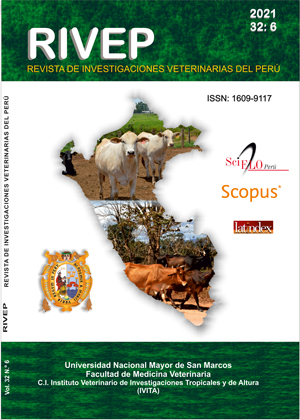Osteological description of the taruca (Hipocamelus antisensis) (d'Orbigny, 1834): II. Axial skeleton
DOI:
https://doi.org/10.15381/rivep.v32i6.21703Keywords:
skull, vertebrae, sternum, anatomy, osteologyAbstract
Hippocamelus antisensis (d'Orbigny 1834), commonly called taruca, is a deer that lives in Peru, Bolivia and Chile between 3500 to 5000 m, and is considered a vulnerable species. The axial skeleton of the taruca is described based on four specimens (two males and two females), according to authorization RDG N° 158-2015-SERFOR-DGGSPFFS. The bone pieces were obtained according to the anatomical technique, the description is in accordance with the Veterinary Anatomical List and the measurements as described by Von den Driesch. In the skull, the occipital does not have a very prominent occipital protrusion, the frontal bone is characterized by its horn process and by presenting up to three supraorbital foramina, the lacrimal has a deep fossa and a fissure covered by cartilage, the incisor bone and maxilla are elongated, in the maxilla there is the presence of a dental socket for the canine, the symphysis of the mandible remains until adulthood, the vomer projects caudally relating to the palatine bone, it has 7 cervical vertebrae, 13 thoracic, 7 lumbar, 5 sacral and 7 coccygeal and the sternum with 7 sternebrae, presents a pronounced xiphoid process. It is concluded that the head is elongated due to the characteristics of the maxillary and incisor bones, the presence of foramina and the characteristics of the antlers in the frontal bone can be used for its identification, the existence of the deep lacrimal fossa and a covered fissure. by cartilage, the choanas are divided by the vomer.
Downloads
Downloads
Published
Issue
Section
License
Copyright (c) 2021 Celso Zapata Coacalla, Joel Iván Pacheco Curie, José Carlos Arias Flores

This work is licensed under a Creative Commons Attribution 4.0 International License.
AUTHORS RETAIN THEIR RIGHTS:
a. Authors retain their trade mark rights and patent, and also on any process or procedure described in the article.
b. Authors retain their right to share, copy, distribute, perform and publicly communicate their article (eg, to place their article in an institutional repository or publish it in a book), with an acknowledgment of its initial publication in the Revista de Investigaciones Veterinarias del Perú (RIVEP).
c. Authors retain theirs right to make a subsequent publication of their work, to use the article or any part thereof (eg a compilation of his papers, lecture notes, thesis, or a book), always indicating the source of publication (the originator of the work, journal, volume, number and date).










